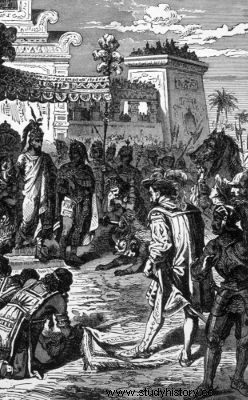
By Me. Cláudio Fernandes
The process ofindependence of Hispanic America occurred in the 19th century, after about four centuries of colonization. In order to understand the complexity of this set of events (which are many, and each one with its own particularity), it is necessary to remember that in the 19th century, since its beginning, there was a lot of turmoil on the European continent. The main reason for this turmoil was the outbreak of the Revolution French, in 1789, and the subsequent installation of the Empire Napoleonic. Spain, then the great metropolis with which Hispanic America was associated, was severely affected by the Napoleonic Wars. The Spanish political maladjustment was decisive for the succession of uprisings in its colonies.
In addition to this external factor, it is necessary that we know what were the internal factors that contributed to this independence process. We can say that, in the same way that the French Revolution was very much inspired by Enlightenment ideas, which were against the absolutist regime, mercantilism, and which preached the ideals of liberty and equality, the first independence movements in Hispanic America were also. Major riots like Tupac Amaru, in Peru, which took place in 1780, and the Movement Commune, which took place in 1781, in New Granada, attest to this fact. Although these movements were stifled by Spanish forces, their pioneering spirit served as a stimulus and example for later movements.
In addition, the political organization of the Spanish colonies greatly disadvantaged the descendants of Spaniards born in the colonies – the so-called criollos. Unlike chapetones, that is, the Spaniards who lived in the colonies and maintained themselves as controllers of the political and administrative scenario, the criollos they had no political power. Due to dissatisfaction with the hegemony exercised by the chapetones , Creole elites were the main agents of the wars for independence. Among the leaders of this elite, four names stand out:Simón Bolivar, José de San Martín ,Bernard O'Higgins e José Sucre. These historical characters became known as the “Liberators of America”, given that they led the wars for the liberation of Hispanic America.
A great political agitator who inspired many of these leaders of the uprisings for independence was the Argentine Bernandro Monteagudo. His pamphlet Dialogues between Atahualpa and Fernando VII in the Champs Elysees , published in 1809, was one of the texts that most contributed to the dissemination of Enlightenment ideals in Hispanic America, as emphasized by historian Maria Lígia do Coelho Padro:
“This was one of many pamphlets that invaded Hispanic America in the first decade of the 19th century, spreading Enlightenment ideas and contributing their arguments to justify the action of those who began to fight for the independence of the colonies in America. These 'subversive' texts produced by the criollos were born from the encounter between the readings coming from Europe and the original reflection conceived from the colonial situation.” [1]
The 1820s were decisive for the wars for independence. Gradually, practically all the territory of the former Spanish colonies was free (with the exception of Cuba, which only became independent in 1898). This independence process was welcomed and welcomed by countries that were interested in establishing direct commercial contacts with Hispanic America, as was the case with the British Empire and the United States of America.
NOTES
[1] PRADO, Maria Ligia Coelho. Radical hope and conservative disenchantment in Spanish American Independence The. History, São Paulo, 22 (2), 2003. p. 20.
